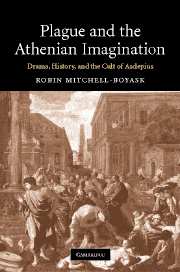Book contents
- Frontmatter
- Contents
- Preface
- Prologue
- Figure 1
- Chapter 1 Introduction
- Chapter 2 Death, myth and drama before the plague
- Chapter 3 Materials I: The language of disease in tragedy
- Chapter 4 Plague, cult and drama: Euripides' Hippolytus
- Chapter 5 Oedipus and the plague
- Chapter 6 The Trachiniae and the plague
- Chapter 7 Materials II: The cult of Asclepius and the Theater of Dionysus
- Chapter 8 Disease and stasis in Euripidean drama: Tragic pharmacology on the south slope of the Acropolis
- Chapter 9 The Athenian Asklepieion and the end of the Philoctetes
- Chapter 10 Conclusions and afterthoughts
- Works Cited
- Index
Chapter 4 - Plague, cult and drama: Euripides' Hippolytus
Published online by Cambridge University Press: 22 September 2009
- Frontmatter
- Contents
- Preface
- Prologue
- Figure 1
- Chapter 1 Introduction
- Chapter 2 Death, myth and drama before the plague
- Chapter 3 Materials I: The language of disease in tragedy
- Chapter 4 Plague, cult and drama: Euripides' Hippolytus
- Chapter 5 Oedipus and the plague
- Chapter 6 The Trachiniae and the plague
- Chapter 7 Materials II: The cult of Asclepius and the Theater of Dionysus
- Chapter 8 Disease and stasis in Euripidean drama: Tragic pharmacology on the south slope of the Acropolis
- Chapter 9 The Athenian Asklepieion and the end of the Philoctetes
- Chapter 10 Conclusions and afterthoughts
- Works Cited
- Index
Summary
Plague struck the Athenians in 430, and its impact, multiplied by the confinement of the area's population inside the city walls for protection against the Spartan attacks (a condition the rustic Dicaeopolis laments at the opening of Aristophanes' Acharnians), is felt in Sophocles' first tragic drama about Oedipus. Moving further inside the walls, to the heart of the polis, Asclepius enters the south slope of the Acropolis by 420, yet thematically he occupies the lower part of the slope several times before then. The social energy released by the increased concern with disease and Asclepius may be seen circulating through Euripides' Hippolytus, which was produced in 428 bce. The extant drama is the second Euripides composed on this subject and, given the timing of the drama's production and the prominence of nosological imagery in its language, it is conceivable that the plague was one of Euripides' motivations in returning to this myth; if nothing else, the plague informs and gives resonance to the tragedy's preoccupation with illness. In this chapter I examine the intersection of disease language and imagery with myths and rituals that involve the threat of famine, with initiatory rituals, and allusions to Asclepius himself.
- Type
- Chapter
- Information
- Plague and the Athenian ImaginationDrama, History, and the Cult of Asclepius, pp. 45 - 55Publisher: Cambridge University PressPrint publication year: 2007



